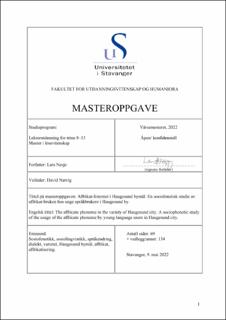| dc.description.abstract | Denne masteravhandlingen er en sosiofonetisk studie av affrikat-bruken hos unge språkbrukere i Haugesund by. Den tar utgangspunkt i to empiriske arbeid: lydopptak utført av Finn Gabrielsen i 1988, samt eget empirisk arbeid høsten 2021. Informantutvalget besto av 30 informanter i 1988 og 20 informanter i 2021. Informantene i Gabrielsens opptak ble intervjuet, mens informantene i 2021-undersøkelsen leste en tekst, samt samtalte i grupper på fem. Teksten informantene leste hadde som formål å avdekke informantenes bruk av affrikat-fonemet i ulike posisjoner hvor dette fonemet historiske hadde historisk belegg. Resultatene ble katalogisert og systematisert med tanke en kvantitativ frekvensfordeling. I forskningsarbeidet var formålet med frekvensfordelingen av affrikatiserte og ikke-affrikatiserte former i informantenes språkbruk å avdekke informantenes bruk av affrikat-fonemet, samt hvilke mulige avvik en kunne finne i denne bruken.
I del 1 setter jeg affrikat-fonemet i en sammenheng med Haugesund, samt plasserer Haugesund geografisk og administrativt på Haugalandet. I del 2 gjør jeg rede for tidligere forskning på affrikater som fonologisk enhet, samt tidligere forskning på palatalisering av velarer i Rogaland. I del 3 går jeg inn i den sosiofonetiske rammen for oppgaven med fokus på både sosiolingvistisk og fonologisk teori. I del 4 går jeg inn i den sosiolingvistiske metoden som er brukt i denne studien, samt de metodologiske valgene jeg har tatt i arbeidet med denne studien. Videre i del 5 presenterer jeg resultatene fra studien, som videre vil bli diskutert i del 6. Til sist i oppgaven ser jeg i del 7 resultatene i lys av problemstillingen og hypotesene gitt i del 1.
Basert på en kvantitativ frekvensfordeling viser resultatene at det ikke er noen tendens til at det i haugesundsvarieteten har funnet sted en lydendring i retning av deaffrikatisering. Resultatene viser derimot at informantene varierer noe i bruken av nektingsadverbialet og leksemet mye i retning av standardnær, ikke-affrikatisert form. Dette blir i studien ansett som leksikalske lån, og ikke en deaffrikatisering som sådan. Studien forsøker også å se etter språkendringsforskjeller mellom kjønnene. Dette gir kun marginale tendenser. Hovedfunnet i studien er at det ikke finner sted en fonologisk deaffrikatisering, og at forklaringen på dette muligens kan tilskrives interne og eksterne påvirkningsfaktorer som virker sammen i en bevaringsprosess av affrikat-fonemet i Haugesund bymål. | |
| dc.description.abstract | This master's thesis is a sociophonetic study of the use of affricates among young language users in Haugesund city. It is based on two empirical works: audio recordings made by Finn Gabrielsen in 1988, and my own empirical work in the autumn of 2021. The informant committee consisted of 30 informants in 1988 and 20 informants in 2021. The informants in Gabrielsen's recordings were interviewed, while the informants in the 2021 survey read a text, as well as conversations in groups of five. The purpose of the text the informants read was to uncover the informants' use of the affricate phoneme in various positions where this phoneme historically had historical evidence. The results were cataloged and systematized with a view to a quantitative frequency distribution. In the research work, the purpose of the frequency distribution of affricated and non-affricated forms in the informants of the affricate phoneme, as well as what possible deviations could be found in this use.
In part 1, I put the affricate phoneme in a context with Haugesund, and place Haugesund geographically and administratively on Haugalandet. In part 2, I describe previous research on affricates as a phonological unit, as well as previous research on palatalization of velars in Rogaland. In part 3, I go into the sociophonetic framework of the thesis with a focus on both sociolinguistic and phonological theory. In part 4, I go into the sociolinguistic method used in this study, as well as the methodological choices I have made in the work with this study. Further in part 5, I present the results from the study, which will be further discussed in part 6. At the end of the thesis, I see in part 7 the results in light of the problem and the hypotheses given in part 1.
Based on a quantitative frequency distribution, the results show that there is no tendency for the Haugesund variety to have a sound change in the direction of deaffricatisation. The results, on the other hand, show that the informants vary somewhat in the use of the refusal adverbial and lexeme much in the direction of standard, non-affricated form. In the study, this is considered a lexical loan, and not a deaffricatisation as such. The study also tries to look for language change differences between the sexes. This gives only marginal tendencies. The main finding of the study is that there is no phonological deaffricatisation, and that the explanation for this can possibly be attributed to internal and external influencing factors that work together in a conservation process of the affricate phoneme in the Haugesund variety of spoken norwegian. | |
